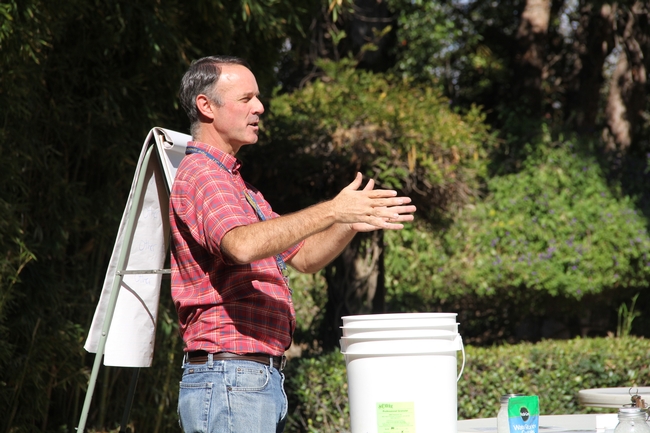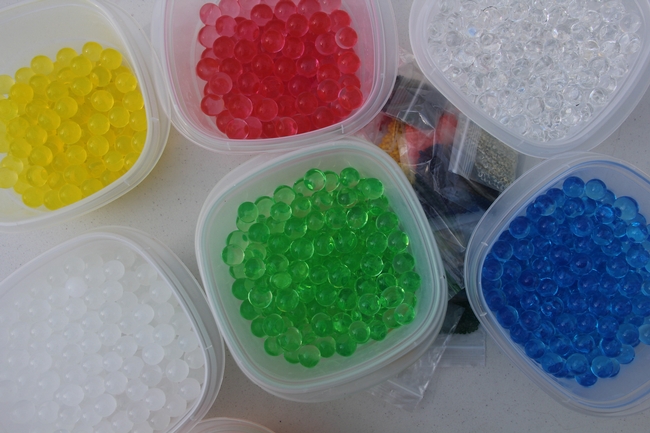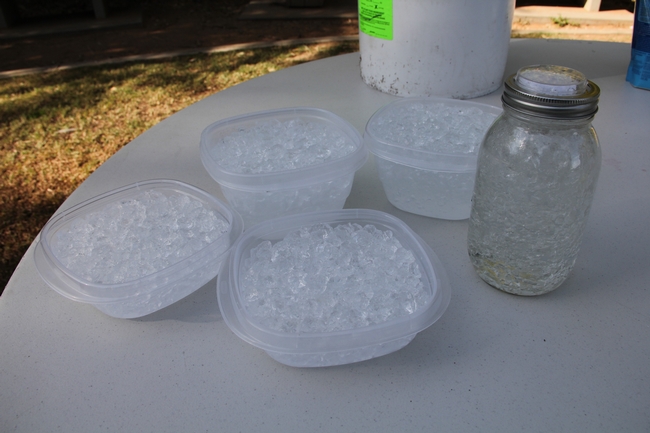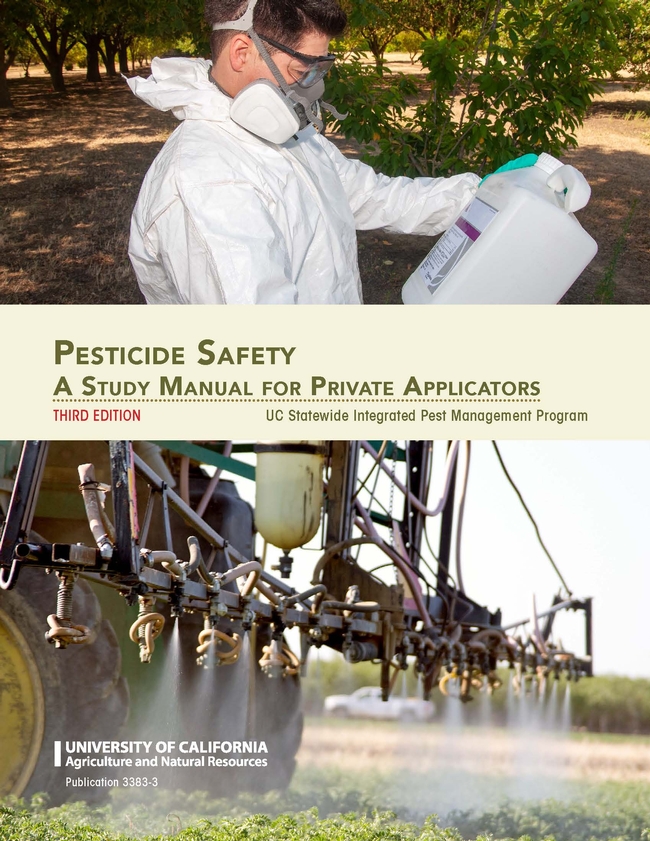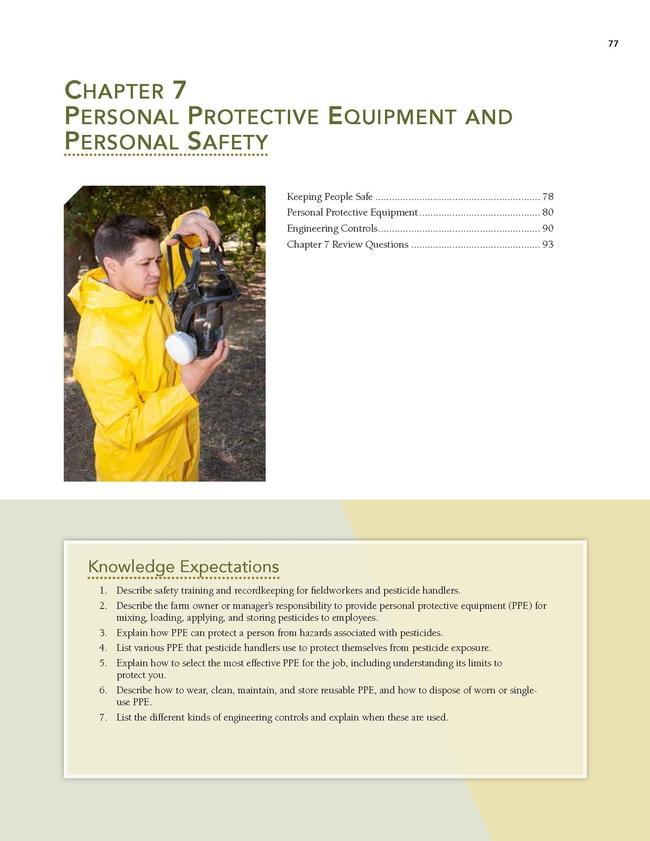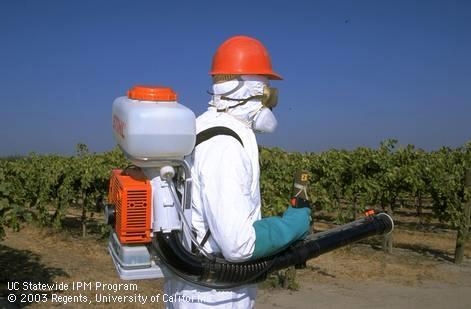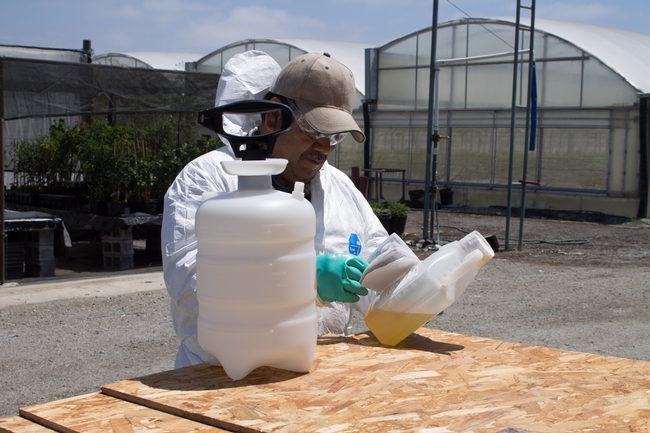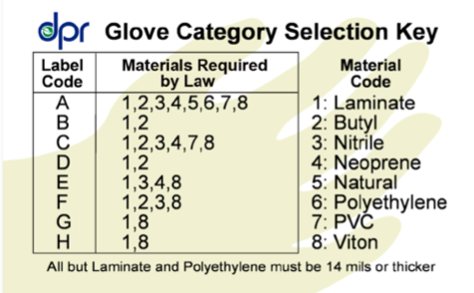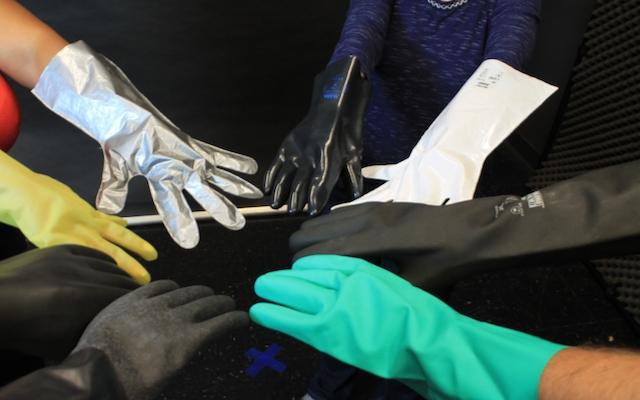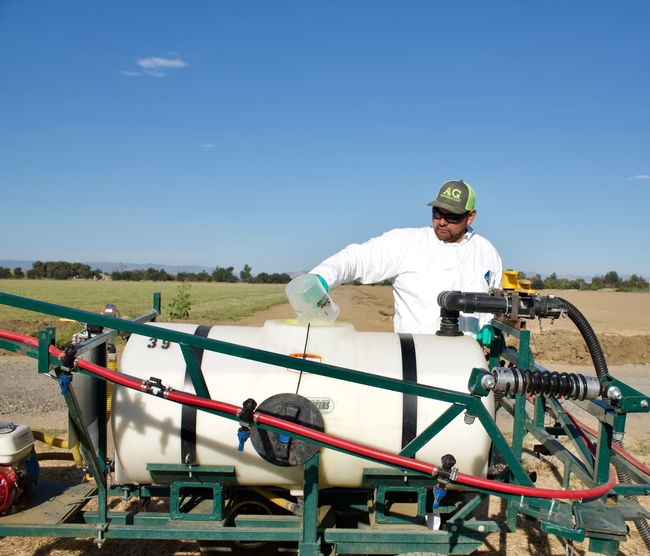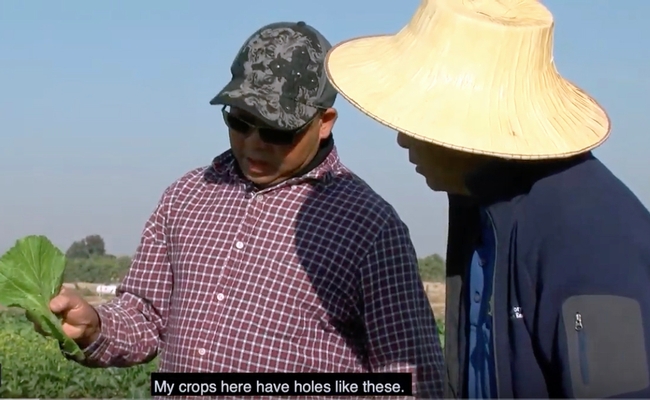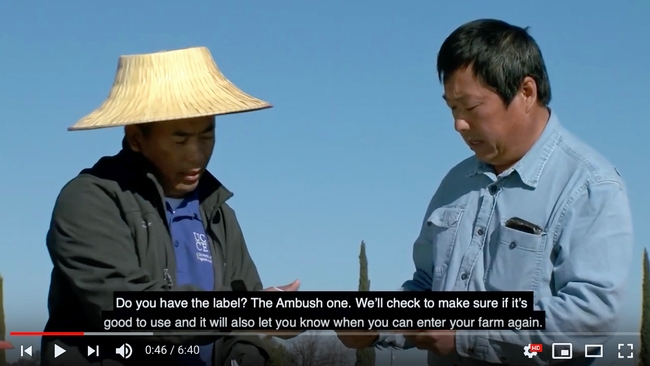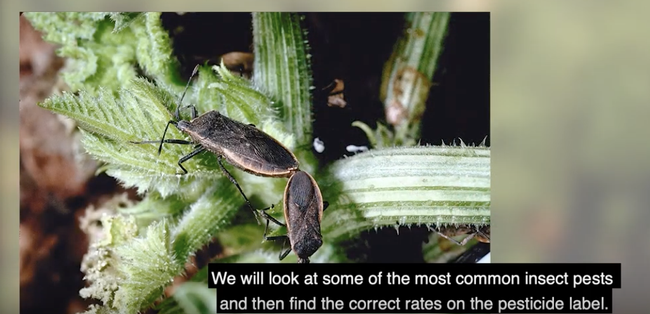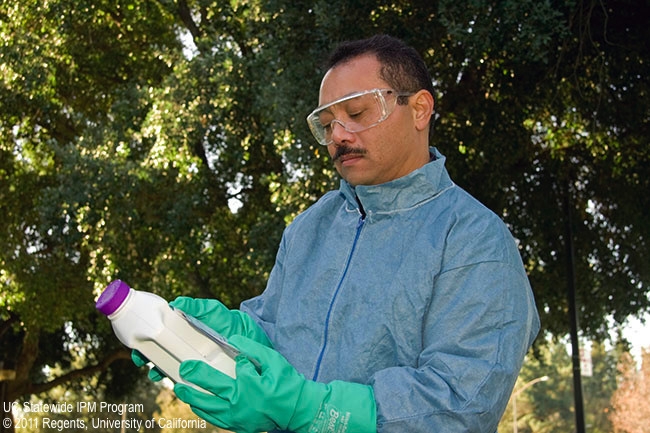Posts Tagged: pesticide
UCCE researchers target sugar-feeding ants, a key to controlling citrus pests, disease
Sugar-feeding ants protect pests that infect trees and damage the fruit they bear. Insecticides are often a go-to solution, but may kill beneficial insects in the process, too. Thankfully, Mark Hoddle, University of California Cooperative Extension entomologist and biological control specialist at UC Riverside, together with UCR colleagues in chemical engineering, developed a biodegradable hydrogel baiting system that targets ant populations, which protect sap-sucking pests from their natural enemies. Control of ants allows beneficial parasitoids and predators to greatly reduce pest populations.
Deciding to expand Hoddle's research was a “no-brainer” according to David Haviland, UC Cooperative Extension farm advisor in Kern County.
Haviland is investigating active ingredients that can be effectively used in hydrogel baiting systems. His research builds on Hoddle's use of alginate gels, also known as water beads, soaked in sugar water to control Argentine ants.
“What we're doing in California can benefit places like Florida, Texas, Mexico and beyond,” Haviland said.
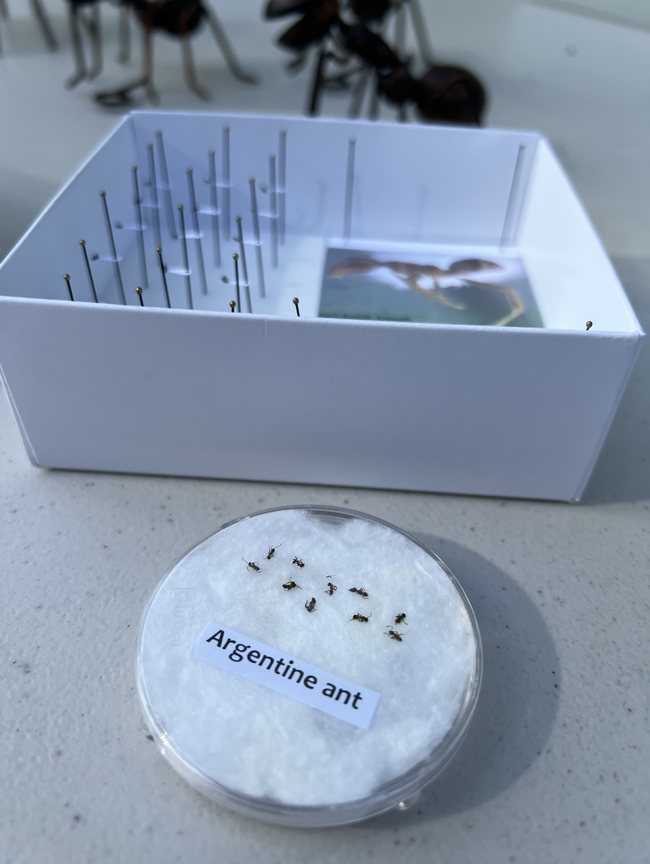
The Hoddle lab conducted two years of orchard research showing that when ants are controlled, the amount of citrus flush infested with Asian citrus psyllid (ACP), a mottled brown insect that vectors the pathogen causing citrus greening, decreases by 75%. Citrus flush refers to newly developed leaves.
“But benefits are not restricted to just ACP with Argentine ant control, as natural enemies destroy colonies of other sap-sucking pests too,” said Hoddle. “For example, citrus mealybug infestations on leaves were completely eliminated by natural enemies, 100% control, while densities of fruit infested by mealybugs were reduced by 50%.”
The Hoddle lab's success inspired Haviland to consider how this approach will fare in different regions of the state where there are different crops, different pests and different ant species.
Haviland has worked for many years on solid baits that are effective and affordable for ants that feed primarily on protein, like fire ants in almonds, but successful control measures for sugar-feeding ants that drink their food have been elusive.
“Therefore, we're using hydrogels to essentially turn a liquid bait into a solid, making it effective and commercially adoptable,” Haviland said. He and his team are assessing whether active ingredients that undoubtedly work against ants, like thiamethoxam, maintain their effects in a hydrogel system.
Unlike Hoddle's biodegradable alginate gels, Haviland is relying on acrylamide gels that are similar to the absorbing material you would find in a diaper. These gels are not organic, but are currently accessible on a commercial scale, and have been shown to be effective in wine grapes on the North Coast by a Cooperative Extension advisor in Napa County, Monica Cooper. Haviland's current research efforts are focused on citrus, table grapes and wine grapes in the San Joaquin Valley, and on lemons on the coast.
The primary challenge now is navigating pesticide regulations and registration.
“This is cutting-edge research,” Haviland said, and manufacturer labels for the products being used need to be updated to include hydrogels as an approved use. This process takes time. Additionally, adding new product uses needs to make economic sense for the manufacturer.
Hoddle and Haviland's research can provide data for adding these methods to the product labels.
“If we can show that this tech works against lots of pests, lots of ant species, in lots of different crops across California, hopefully we'll achieve a critical mass of benefits that motivates product manufacturers to make modifications to their labels,” said Haviland.
Haviland is hopeful about the process, and said he believes that UC ANR is in a prime position to lead innovation for an issue that requires collaboration among specialists, advisors and the industry.
More detail, key updates in new edition of pesticide safety manual
Publication in English, Spanish prepares private applicators for state exam
Expanded from four chapters in the previous edition to 12, the third edition of Pesticide Safety: A Study Manual for Private Applicators aims to be more than just a study guide.
The manual, available for purchase in English and Spanish, provides much more detail on essential processes and procedures that will help keep applicators safe while using pesticides – as well as reduce environmental impacts from misapplication.
Published by University of California Agriculture and Natural Resources in collaboration with the state's Department of Pesticide Regulation, the manual – intended for members of the agricultural community who own, manage or work on farms that use restricted-use pesticides – also includes substantial updates.
“The information in the book they were using was way out of date,” said writer/editor Shannah Whithaus, senior editor for pesticide safety education with UC ANR's Statewide Integrated Pest Management Program. “Also, the book was much, much shorter than it needed to be, because it wasn't providing enough information for people to safely apply pesticides, given the complexity of the regulatory environment we're in now.”
The new manual reflects important changes to federal and state regulations since the publication of the previous edition in 2006.
“There are significant regulatory updates which help you stay up-to-date with safety rules and standards – and protect your workers from overexposure to pesticides,” said Lisa Blecker, technical editor of the publication, and currently a pesticide safety educator at Colorado State University.
In addition to emphasizing the broader ecological ramifications of improper pesticide use, the manual includes information on subjects that might get short shrift in other manuals, such as the correct calibration of equipment to ensure accuracy of application.
“All of that is now in the book and fully fleshed out,” Whithaus said. “[Applicators] are going to be able to do that much more effectively using the new book, compared to the old one – it was really hard to be thorough in 80-some pages.”
The new edition – totaling more than 200 substantive pages – also features a more streamlined and user-friendly layout modeled after a sister publication, The Safe and Effective Use of Pesticides, written for commercial applicators.
“A significant update is a layout that is not only beautiful, but helps you identify key information you need to know in order to make safe and effective pesticide applications,” Blecker explained.
She highlighted the “knowledge expectations” listed at the beginning of each chapter and in the margins of the book, next to the relevant passages. The statements serve as “visual cues” to help readers learn and retain the material they need to pass California DPR's certification exam for private applicators.
And while the manual functions as an improved study aid for owners, managers and workers who apply pesticides, it doubles as a reference that they can turn to for years to come.
“It's going to be able to serve as a reference manual, as opposed to just a study guide,” Whithaus said. “You really will be able to use this book as a tool to help you do better in managing your land.”
The manual, listed at $29, is available for purchase in English at https://anrcatalog.ucanr.edu/Details.aspx?itemNo=3383 and in Spanish at https://anrcatalog.ucanr.edu/Details.aspx?itemNo=3394.
PPE in short supply for farm work during the COVID-19 crisis
Gloves, N95 respirators, coveralls and other gear that workers wear to protect themselves from COVID-19, pesticides, dust and other health hazards are in short supply as priority is given to health care workers during the pandemic.
To reduce the spread of COVID-19, workers may wear homemade face coverings, but for applying pesticides, they must wear respirators specified on the pesticide product label, said Whitney Brim-DeForest, UC Cooperative Extension rice advisor.
Pesticide applicators may use gear that is more protective than required by the product label and regulations. 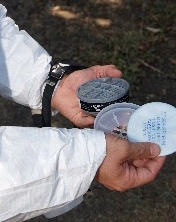
“Although this could change in the days ahead, half-mask and full-mask respirators are more available than disposable N95 respirators for now,” said Lisa Blecker, coordinator for the UC Pesticide Safety Education Program.
Before the pandemic, 10% of N95 respirators from 3M went to health care, but that number is now 90%, the company said in a letter to distributors. This has led to significant backorders of PPE supplies for distributors.
Carl Atwell, president of Gempler's, an online distributor of worker supplies, said that before the crisis, normal lead times for PPE was up to 10 days. He estimated disposable respirators will become available in the fall and other PPE supplies in August.
In the meantime, there is alternative PPE that agricultural professionals can use during the shortage.
Atwell suggests looking for lesser known brands of PPE as opposed to the first tier of choice: “It's sort of like searching for Purell hand sanitizer. Purell brand might be out of stock, but can you find a different disinfectant?”
On Gempler's website, the more recognizable Tyvek coverall from Dupont is sold out, however disposable protective clothing is available from other brands. Reusable chemical-resistant clothing is also available as opposed to their disposable counterparts. Supplies in high demand are reusable and disposable nitrile gloves, protective clothing, disposable respirators and certain protective eyewear, such as goggles and face shields.
For workers who will be applying pesticides, Blecker and Brim-DeForest offered some guidelines on how to meet PPE requirements as the shortage continues.
General PPE requirements: “Remember, the label is the law,” said Brim-DeForest. “PPE requirements for agriculture are not being loosened.” The UCCE advisor recommends purchasing only what you need for the season and choosing reusable PPE whenever possible. Growers who have excess supplies of PPE can coordinate with their county agricultural commissioner or UCCE advisor to help other producers in their area.
Respirators: If you can't find the respirator required on the label, Blecker said, “Use an alternative, more-protective respirator. For example, if an N95 is required, you can use a half-mask with N95 particulate filters; these can be stand-alone filters or ones that attach to an organic vapor cartridge. You could also use a different pesticide that doesn't require a respirator. Consult with your PCA (pest control adviser) for options.”
Gloves: Chemical-resistant gloves, usually 14 mil or more in thickness are required for most California pesticide applications and should be worn by mixers, handlers and applicators. If nitrile gloves are not available, viton and laminate gloves are universal chemical-resistant materials for most pesticide labels. If the glove material is specified on the label, that instruction must be followed.
“Disposable gloves less than 14 mil can be worn, but not for more than 15 minutes at a time,” Blecker said. “Farmers should also note that thinner gloves cannot be layered on top of one another.”
Coveralls: Coveralls should be worn when required by the pesticide label or when the signal word is “WARNING” or “DANGER,” or when applying by backpack or airblast. “Coveralls can be made out of high-density polyethylene fibers (Tyvek and other brands), which are disposable, or cotton, which are reusable,” Brim-DeForest said. “If reusable coveralls are worn, the employer must ensure employees are provided clean coveralls.”
Goggles/face shields: Face shields are required for mixing and loading pesticides only if it's stated on the label. “If a face shield is unavailable, a full-face respirator can be used,” Blecker said. “Goggles or protective eyewear should always be worn in California when handling pesticides, regardless of what the label says. The face shield, goggles or safety glasses must provide front, side and brow protection and meet the American National Standards Institute Z87.1 standard for impact resistance.
The UC Integrated Pest Management Program also covers these topics in their pesticide safety webinar series at http://ipm.ucanr.edu/IPMPROJECT/workshops.html.
For more information about PPE, contact your county agricultural commissioner or see the California Department of Pesticide Regulation's posters at https://www.cdpr.ca.gov/docs/whs/pdf/gloves_for_pesticide_handling.pdf and https://www.cdpr.ca.gov/docs/whs/pdf/n95_alternatives_for_pesticide_handling.pdf.
Hmong-language pesticide safety videos now online
DPR, Fresno State and UCCE create pesticide safety videos with Hmong farmers
A series of videos describing California pesticide rules and safety in Hmong is now available to view for free online. The videos were produced by California State University, Fresno and UC Cooperative Extension in Fresno County with funding from the California Department of Pesticide Regulation.
The nine-part video series – Complying with Pesticide Laws and Regulations in California – is part of DPR's mission to reach California's farming communities. The videos cover a number of topics including using personal protective equipment, understanding pesticide product labels and application permit requirements.
The innovative educational tool blends peer-to-peer communication with traditional extension methods to include the knowledge and experience of both farmers and extension experts. Hmong farmers featured in the video helped develop scenes in which they educate other farmers, purchase and use personal protective equipment, and interact with extension staff.
“We worked with Hmong farmers who are following pesticide regulations themselves, and are now giving back to educate their peers,” said Ruth Dahlquist-Willard, UC Cooperative Extension small farm advisor, who collaborated on the video production. “Their voices and expertise helped make the scenarios more realistic and accessible to other farmers in the Southeast Asian community.”
Michael Yang, longtime UC Cooperative Extension small farms and specialty crops agricultural assistant, stars in the videos, interacting with farmers based on his extensive experience and trusted relationships in the Hmong farming community, and narrating the educational content in Hmong.
“We hope the videos broaden the reach of our local extension programming to help more farmers understand pesticide regulations and avoid fines, as well as improve their safe handling, selection and use,” said Yang.
Dahlquist-Willard and Yang plan to show the videos at UC Cooperative Extension meetings with Hmong farmers and distribute copies on flashdrives to county Agricultural Commissioner's offices in Fresno County and beyond. The videos are captioned in English.
“DPR works with all types of farmers on pesticide issues and it's critical that they use these tools safely – regardless of the language they speak,” explained DPR Director Val Dolcini. “This video project, the first of its kind to use Hmong speakers, will help foster safer use of pesticides.”
The videos can be viewed at http://bit.ly/fs-dpr-hmong-pesticide-video. The modules in the series cover:
- Introduction to California Pesticide Laws
- Checking for Crops Registered on the Label
- Pests and Application Rates on the Label
- Understanding Signal Words
- Following the Restricted Entry Interval (REI)
- Following the Pre-harvest Interval (PHI)
- Knowing Common Restrictions on the Label
- Using Personal Protective Equipment (PPE)
- Pesticide Permits and Reporting requirements
The project took 700 hours over 18 months to complete, including filming and post-production. Twelve Fresno State students were also involved in producing the videos with the Hmong farmers in Fresno County. Dahlquist-Willard and Yang provided the creative direction in partnership with the farmers involved, and Fresno State's MCJ Multimedia Production Service under Professor Candace Egan brought professional video production and editing skills to make a high-quality finished product. Fresno State student video editor Mali Lee, a fluent Hmong speaker, completed the final edits of the Hmong language material.
“This was one of the most rewarding projects I have ever worked on,” said project director Bill Erysian of Fresno State. “We brought together a unique group of agricultural specialists, students, farmers and video professionals to create a high impact, professional set of educational videos on pesticide compliance for our Hmong farmers here in California.”
DPR has comprehensive pesticide safety and outreach material available in Punjabi, Spanish and English at https://www.cdpr.ca.gov/docs/whs/worker_protection.htm.
Looking to hire a maintenance gardener? Make sure they are DPR certified
Memorial Day Weekend has just passed, bringing with it the unofficial start of summer. The warm weather we've recently experienced following a rich rainy season is the perfect combination for the luscious growth we see in lawns and landscapes.
Business picks up this time of year for the many maintenance gardeners who are hired to mow lawns, clean up landscapes, or get rid of unwanted insects, diseases, or weeds. What many people may not realize is that maintenance gardeners who apply pesticides as part of their services must be certified by the California Department of Pesticide Regulation (DPR). Even if pesticides are not used often, such as a single herbicide application, a Qualified Applicator Certificate in the Maintenance Gardener Category Q (QAC-Q) is required. This certification allows maintenance gardeners to legally apply general use pesticides as part of their services.
According to DPR, approximately two-thirds of pesticide exposure-related illnesses reported between 2005 and 2014 in California came from urban settings such as parks, gardens, schools and homes. Maintenance gardeners with a QAC-Q are qualified to follow California laws and regulations that help them to use, transport, store and dispose of pesticides safely in order to avoid human injury and contamination of the environment. They are also trained in pest identification and alternative methods to managing pests without the use of pesticides.
If you are a homeowner and use maintenance gardener services or are looking to hire, be sure to use one that is certified by DPR to ensure that they have the qualifications to follow the law and apply pesticides safely around your home. View the DPR Maintenance Gardener leaflet for homeowners and consumers (PDF) for more information on what you can do.
If you are a maintenance gardener and not yet certified, visit the UC Statewide Integrated Pest Management Program (UC IPM) website for resources to help you. The exam preparation page lists several materials such as a study guide available for purchase as well as free online modules and practice exam questions, available in both English and Spanish.
Those who already hold a QAC-Q must renew it by taking eight hours of DPR-approved continuing education (CE) courses every two years, with at least two hours in the laws and regulations category. Find approved online courses on the UCIPM training page.
For more information about the Qualified Applicator Certificate in the Maintenance Gardener Category, check out the DPR website and DPR's quick reference pocket guide (PDF).
